![]()
Franz Joseph Müller (1740-1825) was born in the Alps, studied law, philosophy and mining, and at age 28 became a mine surveyor. He became the chief inspector of all mines, smelters, and salt-works in Transylvania. In 1782 Müller extracted from a bluish-white ore of gold a metal first thought to be antimony. But a year later he decided it different from all other metals. In 1798 Martin Klaproth proposed to the Academy of Sciences in Berlin to call the metal Tellurium (Te = #52): Tellus is the (Latin) name for the earth. In 1798 no element had been named for the earth, and it needed to be done! Klaproth isolated Tellurium by dissolving Gold ore in aqua regia, precipitating and removing Gold and ferric oxide with excess alkali, then adding hydrochloric acid until, when neutral, another precipitate formed. After collecting and washing this precipitate, he formed a paste with oil and heated to redness. The Tellurium formed metallic globules.
 Antoine Lavoisier's new chemistry was founded on weight as the property critical for determining if a reaction separated or combined substances. But it was customary to ignore or compensate for losses during transfers and other laboratory procedures. Martin Heinrich Klaproth (1743-1817 shown at right and below) helped change chemistry from qualitative to quantitative. Born in Germany the same year as Lavoisier, Klaproth was apprenticed at age 16 as an apothecary. He became interested in chemistry and avidly educated himself. Earlier chemists including Lavoisier recalculated results so they totalled 100%. Klaproth published actual weights of samples and precipitates so any errors were apparent. He addressed sources of errors by developing procedures to purify reagents, avoid contamination from apparatus, and introduced drying samples until constant weight was obtained. When mineral analyses failed to total 100%, Klaproth investigated and either discovered or verified the discovery of Zirconium, Uranium, Tellurium, and Titanium.
Antoine Lavoisier's new chemistry was founded on weight as the property critical for determining if a reaction separated or combined substances. But it was customary to ignore or compensate for losses during transfers and other laboratory procedures. Martin Heinrich Klaproth (1743-1817 shown at right and below) helped change chemistry from qualitative to quantitative. Born in Germany the same year as Lavoisier, Klaproth was apprenticed at age 16 as an apothecary. He became interested in chemistry and avidly educated himself. Earlier chemists including Lavoisier recalculated results so they totalled 100%. Klaproth published actual weights of samples and precipitates so any errors were apparent. He addressed sources of errors by developing procedures to purify reagents, avoid contamination from apparatus, and introduced drying samples until constant weight was obtained. When mineral analyses failed to total 100%, Klaproth investigated and either discovered or verified the discovery of Zirconium, Uranium, Tellurium, and Titanium.
 In 1789 Klaproth dissolved pitchblende, primarily an ore of Iron and Zinc, in nitric acid. When neutralized by potash, a yellow precipitate revealed the presence of a new earth which, by Lavoisier's new chemistry, must contain a new element. Klaproth named the new element Uranium (U = #92) after the planet Uranus which had been discovered by William Herschel eight years earlier. Uranos was the Greek god of the Heavens. Upon intense firing of an oily mixture, Klaproth obtained a lustrous black powder which seemed to be the new metal. (This was a common technique using the oil to react with the earth's oxygen or sulfur, leaving behind the metal.) When the University of Berlin was founded, Klaproth, then sixty-seven years old, was appointed its first professor of chemistry and there taught until his death. In 1841 Eugène Melchior Peligot (1811-1890) reduced uranous chloride (UCl4) with the more reactive Potassium, revealing metallic Uranium and suggesting Klaproth's black powder was likely still an oxide.
In 1789 Klaproth dissolved pitchblende, primarily an ore of Iron and Zinc, in nitric acid. When neutralized by potash, a yellow precipitate revealed the presence of a new earth which, by Lavoisier's new chemistry, must contain a new element. Klaproth named the new element Uranium (U = #92) after the planet Uranus which had been discovered by William Herschel eight years earlier. Uranos was the Greek god of the Heavens. Upon intense firing of an oily mixture, Klaproth obtained a lustrous black powder which seemed to be the new metal. (This was a common technique using the oil to react with the earth's oxygen or sulfur, leaving behind the metal.) When the University of Berlin was founded, Klaproth, then sixty-seven years old, was appointed its first professor of chemistry and there taught until his death. In 1841 Eugène Melchior Peligot (1811-1890) reduced uranous chloride (UCl4) with the more reactive Potassium, revealing metallic Uranium and suggesting Klaproth's black powder was likely still an oxide.
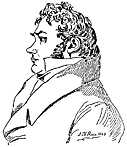 At age 22, Jöns Jacob Berzelius (1779-1848 shown at right) earned a degree in medicine at Upsala and the following year was appointed assistant professor of medicine, botany, and pharmacy at the medical school in Stockholm where he served the rest of his life. His lectures using demonstrations attracted students of chemistry from all over Europe. He and his students had a profound impact on chemistry. He determined the atomic weights of nearly all elements, and was the first to do so accurately. He discovered Selenium, Silicon, Thorium, Cerium and Zirconium and his students discovered many more elements.
At age 22, Jöns Jacob Berzelius (1779-1848 shown at right) earned a degree in medicine at Upsala and the following year was appointed assistant professor of medicine, botany, and pharmacy at the medical school in Stockholm where he served the rest of his life. His lectures using demonstrations attracted students of chemistry from all over Europe. He and his students had a profound impact on chemistry. He determined the atomic weights of nearly all elements, and was the first to do so accurately. He discovered Selenium, Silicon, Thorium, Cerium and Zirconium and his students discovered many more elements.
In 1797 the Finnish chemist Gadolin discovered in a dense black mineral a new earth, yttria (and therefore the new element within, Yttrium). Klaproth and Vauquelin also studied the earth yttria. Wilhelm Hising (changed to Hisinger after he was raised to nobility) was born 1766 to a wealthy Swedish family owning the Bastnäs mine. At age 15 he sent samples of a very dense mineral from the mine to Carl Scheele who found nothing new. In 1803 Hisinger, Klaproth, and Berzelius studied samples from Bastnäs expecting to find yttria. They isolated an earth similar to yttria but recognized it was distinct. Klaproth called it terre ochroite. Hisinger and Berzelius "called the mineral cerous oxide, because there is a higher oxide (ceric oxide), and the two oxides give salts of different colors and properties. The root name Cerium (Ce = #58) was derived from that of Ceres, the first asteroid, discovered two years previous by Piazza. Ceres was the Roman Goddess of corn and harvest. Their efforts to isolated the element were unsuccessful. Mosander and Wohler later obtained rather impure brown powders. A 98% pure sample was finally isolated in 1911 after three years labor by Alcan Hirsch at the University of Wisconsin.
Berzelius owned stock in a sulfuric acid plant that used pyrite from a mine at Fahlun, 100 miles north of Stockholm. In 1817 Berzelius analyzed a red deposit left from burning Sulfur from Fahlun but not other sources and found what seemed to be Tellurium. But by February 1818 he wrote that it was a new substance with interesting properties: it sublimes in the form of flowers of a cinnabar red... During cooling it remains fluid so one can shape it between the fingers and draw it into threads... It burns with an azure blue flame, and gives a very strong odor of radishes; it was this odor that made us think it was Tellurium.
But Berzelius determined that purer Tellurium did not have as strong an odor, so decided the odor in Tellurium was due to impurities of this new substance. Since Klaproth had named Tellurium for the earth, Berzelius thought it appropriate to name the sister element for the earth's satellite: Selenium (Se = #34). Selene is the (Greek) name for the moon.
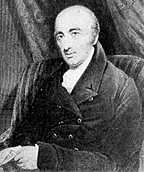 William Hyde Wollaston (1766-1828) was born to an English clergy family and educated as a physician. He became a chemist and physicist with wide ranging interests. He invented a process for making the brittle metal Platinum malleable using spongy powdered Platinum which allowed him to retire from medicine at age 34. He was said to resemble Cavendish in temperament and mental habits. He was pleasant in appearance, very polished and gentle in manners, and clear in conversation. He was gifted with spirit of justice and moderation in views so that it became a proverb that
William Hyde Wollaston (1766-1828) was born to an English clergy family and educated as a physician. He became a chemist and physicist with wide ranging interests. He invented a process for making the brittle metal Platinum malleable using spongy powdered Platinum which allowed him to retire from medicine at age 34. He was said to resemble Cavendish in temperament and mental habits. He was pleasant in appearance, very polished and gentle in manners, and clear in conversation. He was gifted with spirit of justice and moderation in views so that it became a proverb that whoever argued with Wollaston was wrong!
He studied Columbium and Tantalum, gout, diabetes, and served as Secretary of the Royal society. A Century earlier it had been noticed that some Brazilian white Gold and Platinum were brittle and unworkable. In 1803 Dr. Wollaston separated a metal from such Platinum by dissolving in aqua regia, evaporating excess acid, then adding mercurous cyanide solution drop-wise forming a yellow precipitate. When washed and ignited, a white metal remained. Alternately, the yellow precipitate could be heated with Sulfur and borax to yield a button of new metal. Wollaston named the metal Palladium (Pd = #46) after Pallas (Athene), the second asteroid, discovered a year earlier. Pallas was the Greek goddess of wisdom. A second new metal, Rhodium, was obtained by neutralizing the aqua regia with caustic soda.
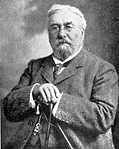
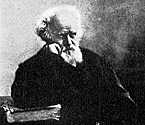 French astronomer Pierre-Jules-César Janssen (1824-1907 photo at left) went to India to observe the 1868 total solar eclipse and to make the first spectroscopic study of the sun's chromosphere. He noted a yellow spectral line which did not quite match Sodium or any other element. The English astronomer Sir Norman Lockyer (1836-1920 photo to right) proposed that the spectral line was due to an element on the sun which he called Helium (He = #2) for Helios, the (Greek) name for the sun.
French astronomer Pierre-Jules-César Janssen (1824-1907 photo at left) went to India to observe the 1868 total solar eclipse and to make the first spectroscopic study of the sun's chromosphere. He noted a yellow spectral line which did not quite match Sodium or any other element. The English astronomer Sir Norman Lockyer (1836-1920 photo to right) proposed that the spectral line was due to an element on the sun which he called Helium (He = #2) for Helios, the (Greek) name for the sun.
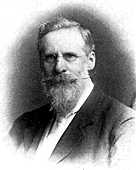
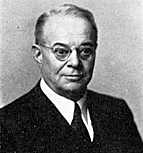 In 1888-90 the American William F. Hillebrand noticed that the mineral uraninite treated with acid released an inert gas which he believed to be Nitrogen. Sir William Ramsay read of Hillebrand's finding, but disagreed with his explanation. He repeated the experiment with a similar mineral called cleveite. He obtained spectra for Nitrogen, Argon, and another gas. Ramsay sent samples to Lockyer and Sir William Crookes (1832-1919 at right). Crookes wrote
In 1888-90 the American William F. Hillebrand noticed that the mineral uraninite treated with acid released an inert gas which he believed to be Nitrogen. Sir William Ramsay read of Hillebrand's finding, but disagreed with his explanation. He repeated the experiment with a similar mineral called cleveite. He obtained spectra for Nitrogen, Argon, and another gas. Ramsay sent samples to Lockyer and Sir William Crookes (1832-1919 at right). Crookes wrote There is argon in the gas; but there was a magnificent yellow line, brilliantly bright, not coincident with, but very close to, the sodium yellow line... Helium is the name given to a line in the solar spectrum, known to belong to an element, but that element has hitherto been unknown on the earth... I telegraphed to Berthelot at once yesterday: GAS OBTAINED BY ME CLEVEITE MIXTURE ARGON HELIUM. CROOKES IDENTIFIES SPECTRUM
The Swedish chemist Per Theodor Cleve, for whom cleveite was named, had his student Nils Abraham Langlet investigate it. Langlet independently found Helium and found its atomic weight more accurately. In 1898 Professor Raffaello Nasini of Padua found trace amounts of Helium in volcanic gases. In 1903 Hamilton P. Cady (1874-1943 shown at left) and D.F. McFarland found many Kansas gas wells contain several percent Helium.
In 1919 Ernest Rutherford, surveying the effects of alpha radiation on light elements, found that bombardment of nitrogen occasionally produced cloud chamber trails longer than those normally produced by alpha radiation. He presumed that the collisions occasionally knocked out a proton, long thought the building block of nuclei. The less massive and less charged proton, receiving much of the alpha particle's kinetic energy, would travel further in air. This experimental confirmation of the existence of the proton was also the harbinger affirming the alchemists' dream of transmuting materials. By absorbing an alpha ray (42α = He) and releasing a proton (11H), the nitrogen nucleus transmuted to oxygen:
After James Chadwick confirmed the neutron in 1932 using the conservation laws of momenta and energy, Enrico Fermi proposed that neutrons would be better for transmutation because they lacked the positive electric charge that caused alphas and protons to repel from nuclei. Fermi, Segré, and coworkers in Rome, Marie Curie in Paris, and Hahn, Lise Meitner, and Strassmann in Berlin attempted and reported success at making atoms of new elements heavier than Uranium, the heaviest natural element. However Meitner was troubled by inconsistencies between the masses and decay energies of the super-heavy elements and those predicted using Einstein's E = mc2. In December 1938 Strassmann identified a radioactive product as chemically indistinguishable from Barium. While others tried to determine how an element beyond Uranium could be in the same chemical family as Barium, Meitner realized that new elements were actually fission products roughly half the mass of Uranium. This negated all prior claims for discovering elements beyond Uranium.
With the discovery of Radon, it had been realized that radioactive gases could evaporate from a source then deposit daughter radioactive materials some distance away. In 1908 Hahn realized that emission of an alpha could create sufficient recoil that even solid decay products could evaporate and be deposited nearby. Meitner proposed that using very thin foil sources would optimize recoil emissions and be a valuable technique for detecting new alpha decay products. In 1939 when Meitner negated prior claims for discovering trans-Uranium elements, Ed McMillan at Berkeley (at right in group below) noted that when thin foils of Uranium were bombarded by slow neutrons, beta activity with half-life of 23 minutes remained. This was associated with another beta emitting isotope with a half-life of 2.3 days. Unlike alpha radiation, the lighter-mass beta rays would not produce enough recoil to eject the other product. McMillan suspected the longer-lived isotope might be 23992U which produced the shorter-lived daughter by beta decay:
Step 2: 23992U → 0-1β + 23993Np t1/2 = 2.3 day long decay
 Joined in 1940 by Phil Abelson (←at left), McMillan found the new isotope had IV and VI oxidation states which allowed them to chemically separate and identify the trace amount of element #93 from the much more abundant Uranium. They called the new element Neptunium (Np = #93) because it was the next element after Uranium on the periodic chart and the next planet after Uranus was Neptune. Neptune was the god of the seas.
Joined in 1940 by Phil Abelson (←at left), McMillan found the new isotope had IV and VI oxidation states which allowed them to chemically separate and identify the trace amount of element #93 from the much more abundant Uranium. They called the new element Neptunium (Np = #93) because it was the next element after Uranium on the periodic chart and the next planet after Uranus was Neptune. Neptune was the god of the seas.
Suspected formation: 23893Np → 0-1β + 23894Pu t1/2 = 23 minute short decay
 Ed McMillan immediately started looking for the shorter lived beta decay daughter of Neptunium which would be element #94. Before he could finish, he was called away to work on World War II efforts at MIT to develop radar. Glenn T. Seaborg who lived a couple doors away in the Faculty Club, asked to continue the search. (Seaborg is on left of group registering the national historic site at the 25 year anniversary.) Joined by graduate student Arthur Wahl (in middle of group below) and fellow instructor Joe Kennedy (at right →) they bombarded U3O8 with deuterons using Ernest Lawrence's 60" cyclotron. They separated a mixture of 23893Np and 23993Np which grew an alpha emitting isotope with a half-life of about 90 years:
Ed McMillan immediately started looking for the shorter lived beta decay daughter of Neptunium which would be element #94. Before he could finish, he was called away to work on World War II efforts at MIT to develop radar. Glenn T. Seaborg who lived a couple doors away in the Faculty Club, asked to continue the search. (Seaborg is on left of group registering the national historic site at the 25 year anniversary.) Joined by graduate student Arthur Wahl (in middle of group below) and fellow instructor Joe Kennedy (at right →) they bombarded U3O8 with deuterons using Ernest Lawrence's 60" cyclotron. They separated a mixture of 23893Np and 23993Np which grew an alpha emitting isotope with a half-life of about 90 years:
Step 1: 21H + 23892U → 23993Np + 10n bombardment
Step 2: 23993Np → 23994Pu + 0-1β spontaneous decay
Decay: 23994Pu → 42α + 23592U t1/2 = 90 year decay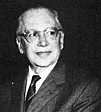
 On 28 January 1941 under the names McMillan, Wahl, Kennedy and Seaborg they announced their finding of element #94. But they felt they needed chemical evidence. Using the strongest aqueous oxidizing agent they could find, peroxydisulphate with a Silver ion catalyst, they isolated the isotope. Joined by Emilio Segrè, (on right at 25 year anniversary) from Fermi's emigrated Italian group, they found that element #94 fissioned when struck by slow neutrons. Among themselves they called the new elements by their numbers. But where they might be overheard they used the code names of
On 28 January 1941 under the names McMillan, Wahl, Kennedy and Seaborg they announced their finding of element #94. But they felt they needed chemical evidence. Using the strongest aqueous oxidizing agent they could find, peroxydisulphate with a Silver ion catalyst, they isolated the isotope. Joined by Emilio Segrè, (on right at 25 year anniversary) from Fermi's emigrated Italian group, they found that element #94 fissioned when struck by slow neutrons. Among themselves they called the new elements by their numbers. But where they might be overheard they used the code names of Silver
and Copper.
When they had occasion to use real Copper they called that honest-to-God Copper.
When in 1942 a name was needed, they felt it was obvious that they should follow McMillan's lead and call the new element Plutonium (Pu = #94): The second element after Uranium on the periodic chart should be named for the second planet after Uranus, Pluto. Pluto was the god of the underworld. They felt that name sounded better than the alternate "Plutium." They playfully proposed the symbol Pu rather than Pl, but did not get the objections they expected.
Nuclear MilestonesVol.1 Builders & Discoverers, U. S. Atomic Energy Commission, May 1971 (signed copy)
![]()

| introduction | alchemy | planets | color | other properties | myths | people | minerals | ore mines | other places | combination names |
| to site menu | Introduction to Development of Periodic Chart |
18th Century vocabulary, & index of people |
chemistry | physics | ||||||
| created 31 December 2000, amplified 1 April 2001 minor revision 16 June 2007 |
by D Trapp | |||||||||